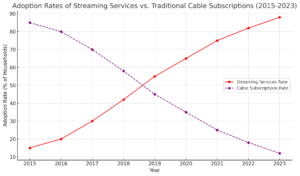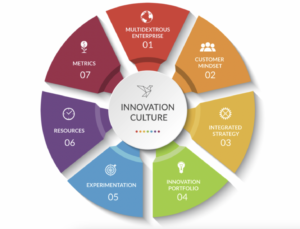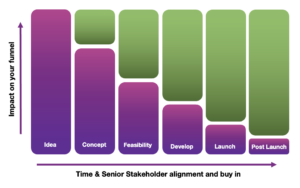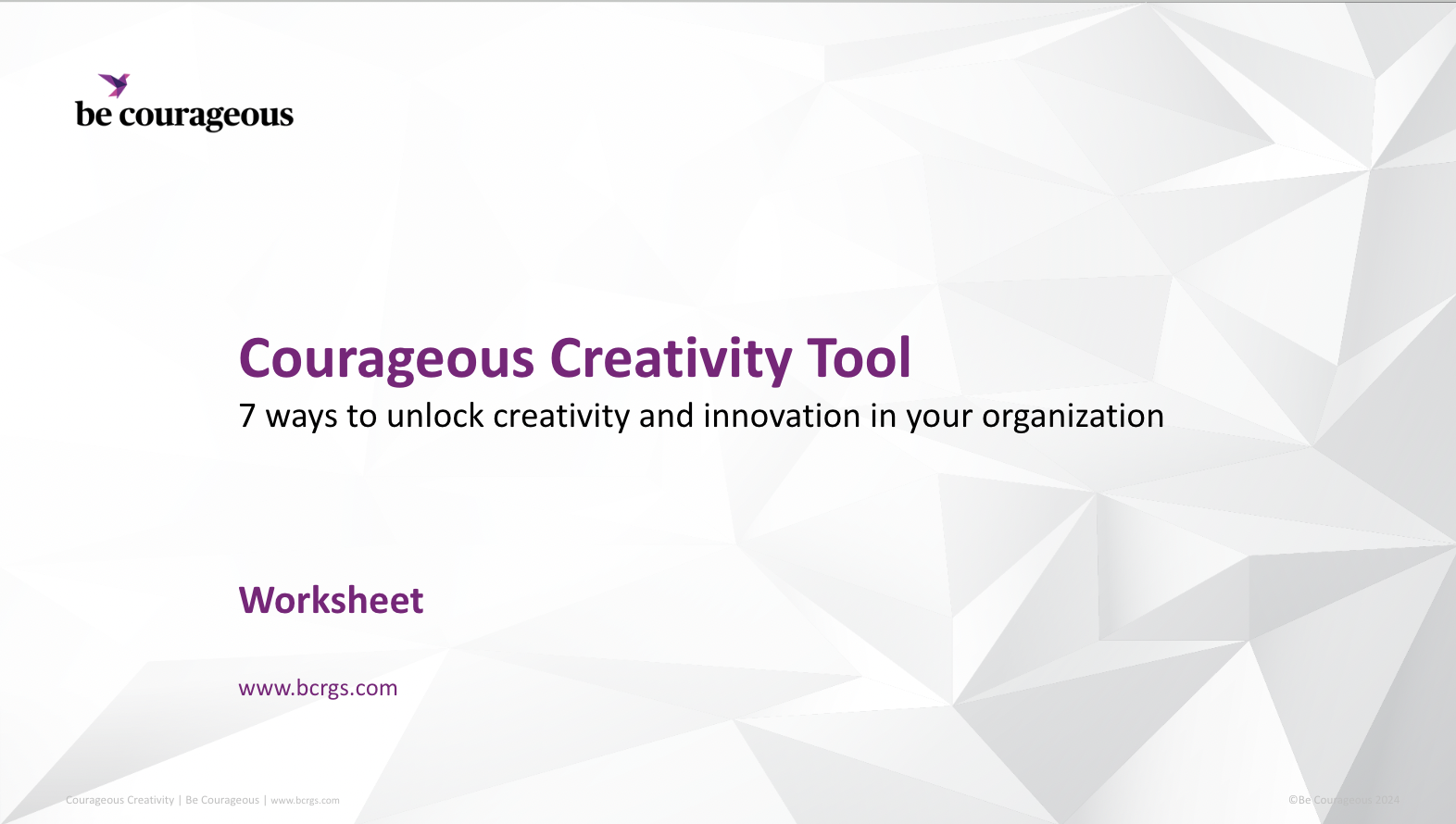7 ways to unlock creativity and innovation in your organization.
Creative roles within companies have been historically organized in separate departments.
Research and development, innovation and product development teams, graphic designers, writers, and dreamers were all “over there,” separate from financial, sales, and leadership teams.
Those days can be no longer.
These days, major shakeups to humanity that used to be seen once or twice a century are arriving weekly.
Be Courageous friend Dr. Shuo Chen, (General Partner at IOVC, Faculty at UC Berkeley, and Entrepreneurship Lecturer at Stanford), tells us that practicing and developing creativity is no longer a “nice to have” or a “maybe when I have time” concept and skill set.
To thrive in an environment of unpredictable firsts, courageous creativity must be embedded in every role across an organization.
Why is the world changing so rapidly?
One reason we’re seeing our world change so rapidly is that human beings, worldwide, have more access to tools, resources, and each other, than ever before.
Increased accessibility allows ideas, solutions, and breakthroughs to happen from anywhere and from anyone.
Now a musician, without the help of a major label, can publish their album and have it immediately available to millions. An entertainer can create a video that’s shared around the world in mere minutes.
Accessibility, and affordability, are at an all-time high
Humans not only have the most access at their fingertips to create change but tools and resources have never been so affordable.
Take Zoom, for example.
Zoom launched in 2013, and the maximum number of participants able to join a virtual call was 15. Groundbreaking at the time!
Now, in 2024, Zoom has reached the ability to handle one million people in a virtual room. One million! That means they could host every single person living in San Jose, the third largest city in California. Or the entire population of the state of Montana or the country of Fiji.
In just over a decade, Zoom increased its ability by 6M%, and all at a relatively low price to its customers.
It doesn’t stop at Zoom. Clever solutions are being created daily that shift behaviors and ways of life.
Ideas and products that were once absurd, are now becoming commonplace.
“The future is here, it’s just not evenly distributed”
This quote from science fiction writer William Gibson describes how advancements are accessible to some people earlier than others, highlighting the uneven spread of the future across society. But that is changing.
More humans than ever are trying to solve humanity’s issues (like SDGs), and we’re seeing an exponential curve of access, solutions, and adoptions.
The more people create solutions, the more those solutions will be adopted.
For example, here’s a graph of the lightning-fast adoption of streaming services over traditional cable in the last decade.

What are the best conditions for creative innovation?
There are two motivating factors for innovation.
- People, in reactive mode, are frustrated by a situation or product and work to improve it.
- People, in a proactive mode, race to see who can create the next, best, first thing. This could be by advancing current product lines based on ideas like, “I wish this product did this and not that,” or, they invent an entirely new way of doing business (like the shift from hotels and taxis to AirBnBs and Lyfts).
Innovation boils down to people creatively working together to drive a new idea forward, beyond resistance, to eventually become “the new normal.”
The role of courageous creativity
With so many driven people wanting to put a dent in the universe and make a change, you either have to start creating and disrupting, or you will be out-created and disrupted.
In our work with companies from Fortune 1000 to challenger brands and some of the fastest disrupters in all industries, we’ve been consistently tracking, auditing, and paying attention to the most critical elements that must be present for courageous creativity and innovation to thrive.
Here’s what we’ve learned. (Note: Keep in mind that no company on this planet is doing all areas well at once. The best are doing up to five, and are working on better capabilities in the other two.)
7 key focus areas to embed innovation and creativity
There are seven key elements for creativity and innovation success.

(01) Multidextrous enterprise
Multidextous enterprise is the ability to move between experimenting and exploring and operational execution and rigor. It means you can have a future-focused mindset with curiosity, experimentation, and discovery, AND continue to make incremental improvements, build processes and systems, and think about your shareholders, investors, employees, and customer expectations. More on honing your ambidexterity skills here.
(02) Consumer mindset
The consumer mindset is one’s ability to have a customer-centric focus when developing new ideas. A consumer mindset helps you make sure you’re not just answering the business question, but you’re answering the consumer one. It’s asking questions like, “How can I help our customers? What’s going on in the life of your consumers?”
Sometimes a customer knows what they need, and sometimes they don’t. This mindset is to build a relationship with the person you’re serving. If customers can’t answer what they need, think about the jobs they’re trying to do in the world. What are their pain points?
Have a powerful, neverending conversation with your consumers. Keep asking them, “How can I add value to your life?”
When you’re connected to a customer, since their needs are always changing, you’ll be creating for the future, and not for what’s currently available.
(03) Integrated strategy
Integrated strategy is figuring out what your strategy needs to be for your team and company to be intrinsically connected to your customers, and why. This will be based on numbers one and two above.
Ask: Do we have a strategy, and how is serving our customers linked to it?
(04) Innovation portfolio
Your innovation portfolio is having such a collection and reputation for breakthroughs and “cool, new ideas” that people will line up to see what’s next. It’s when your marketing team is on fire along with your product development team.
For example, whether or not you agree they are still achieving this, historically, Apple released products with a specific, describing all the amazing ways they’ve solved past pain points, as well as offering futuristic services that were sure to “rock our worlds.”
Remember the time when cameras were put into phones? (Okay, maybe I’m of a certain age!) Before cameras were integrated into cell phones, there was not a significant customer demand for this feature. The focus was on improving call quality, signal reception, and portability.
The idea of integrating a camera into a cell phone was driven more by technological possibilities rather than explicit consumer demand. It was the manufacturers, particularly Japanese companies like Sharp and Kyocera, who pioneered this integration in the late 1990s and early 2000s, aiming to combine digital photography with mobile communication.
Once camera phones were introduced, consumer demand quickly grew as people found value in the convenience of having a camera always at hand. Once people realized how convenient it was to carry just one device versus two, and be able to instantly share a photo with someone around the world, it became a standard feature. This shows how innovation often creates new demands that were not previously articulated by the market.
(05) Experimentation
Experimentation means allowing and celebrating the acts of trying (and failing). It is taking on big challenges and trying new ways.
Experimentation also means you have an organizational commitment to push to the edge of what’s possible, where teams are encouraged to find their “fall edge,” break stuff, and learn what could be possible.
Creative labs are where mindset and action meet. Just as you might enter an art studio to paint, give your teams a place to play. To try. Celebrate a try, not just a success.
(06) Resources
Resources include every tool and person who helps you on your mission. It’s having dedicated team members with the right attitude and skill sets, locations/spaces, financial backing, tools, and techniques, Resources could also be strategic partnerships, which can often propel new ideas.
Resources are also a mindset of preparation. As Ray Kurzweil said in, “The Singularity Is Near:”
“An invention has to make sense in the world in which it is finished, not the world in which it is started.”
A mindset of preparation will help you consider the future context and environment in which an innovation will be released, rather than the present circumstances during its development.
(07) Metrics
Metrics are how we measure creativity and innovation. How will you measure what you’re making? A metric could be about a mindset or a measure of how much revenue could be attributed to innovation versus existing products and services.
More courageous creativity metrics ideas:
- Customer satisfaction scores
- How many new ideas you’re putting out to market
- How well or fast you’re executing your strategy
- What return you’re getting on creativity
- How many short, medium, and long=term ideas you have in the works
- How many features are new versus incremental builds
- How far out are you are looking to avoid being disrupted by another company
- How many experimentation sessions (i.e., hackathons) you’ve had
- Reporting on the processes, tools, talent, training, and skills on your team.
As we mentioned at the beginning of this article, sometimes those in the most creative roles work in a silo and are left out of day-to-day operations. Having metrics on creativity allows them to be part of the conversation in a company as a whole.
To be clear, a creativity measure is not a judgment on if an idea is “good” or “bad.” It is simply a measure of creative thinking in general, and how that thinking can help execute on strategy.
The good news is, that if creativity and innovation are solid in your company, you’ll find the money, time, and resources that will make the innovation take hold. Fact!
Making creative innovation stick
I’m often in front of large executive audiences, teaching courageous leadership and guiding organizational transformation.
After a typical session, I scan the audience and witness the participants’ “wow!” faces, giddy with new-found inspiration. Then, I’ll ask: “Raise your hand if you’ve had a transformative experience today and learned something new!”
Nearly everyone raises their hands, excited to go back to work.
I hate to do it, but I have to give them some challenging news.
“Keep in mind, you’ve had a transformative moment here, but you may be going back to an un-transformed environment.”
Yikes.
Just as important as having ideas, is creating a system that allows creativity to be followed through after all the brainstorming and idea-generating is done.
The chart below shows how most people love to be in on the brainstorming phase, but once it’s time to execute and sell the ideas, more and more people fall off the new idea wagon. That is where courageous creativity comes in.

Courageous creativity fills in the gap

Bringing as many people into the fold of the courageous creativity process will keep people excited through the hard processes of testing and releasing innovative ideas.
Where is courageous creativity needed for you and your company?
Where is the courageous creativity needed in your team or company right now? Why is it needed?
If you could bring fresh thinking to an area, where and what would it be?
What new metrics could you institute that could celebrate creativity for its own sake?
Using the tool below, level up your and your team’s courageous creativity skills, and watch transformation blossom.
And as always, our coaches, advisors, and trainers are here to help unlock these skills, either virtually or in person, with any size team and industry.
Co-written/edited: Shannon Geher
Research/images: FIN / Unsplash
Courageous Creativity Tool
Unlock courageous creativity in you, your team, and your company by following these seven steps!


